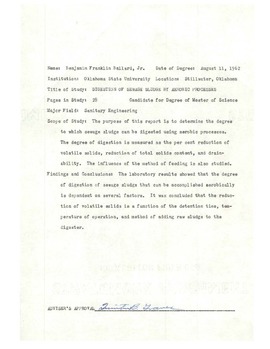| dc.contributor.advisor | Graves, Quintin B. | |
| dc.contributor.author | Ballard, Benjamin Franklin, Jr. | |
| dc.date.accessioned | 2016-06-01T14:40:10Z | |
| dc.date.available | 2016-06-01T14:40:10Z | |
| dc.date.issued | 1962-08 | |
| dc.identifier.uri | https://hdl.handle.net/11244/34804 | |
| dc.description.abstract | Scope of Study: The purpose of this report is to determine the degree to which sewage sludge can be digested using aerobic processes. The degree of digestion is measured as the per cent reduction of volatile solids, reduction of total solids content, and drainability. The influence of the method of feeding is also studied. | |
| dc.description.abstract | Findings and Conclusions: The laboratory results showed that the degree of digestion of sewage sludge that can be accomplished aerobically is dependent on several factors. It was concluded that the reduction of volatile solids is a function of the detention time, temperature of operation, and method of adding raw sludge to the digester. | |
| dc.format | application/pdf | |
| dc.language | en_US | |
| dc.rights | Copyright is held by the author who has granted the Oklahoma State University Library the non-exclusive right to share this material in its institutional repository. Contact Digital Library Services at lib-dls@okstate.edu or 405-744-9161 for the permission policy on the use, reproduction or distribution of this material. | |
| dc.title | Digestion of sewage sludge by aerobic processes | |
| dc.contributor.committeeMember | Hemphill, Louis | |
| osu.filename | Thesis-1962R-B189d.pdf | |
| osu.accesstype | Open Access | |
| dc.type.genre | Master's Report | |
| dc.type.material | Text | |
| thesis.degree.discipline | Sanitary Engineering | |
| thesis.degree.grantor | Oklahoma State University | |
